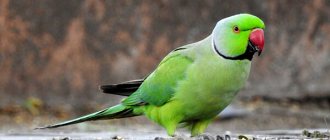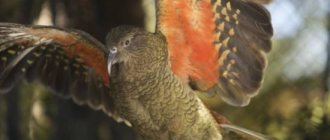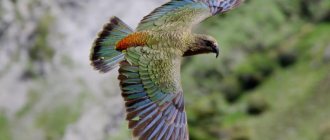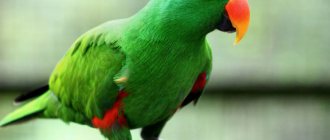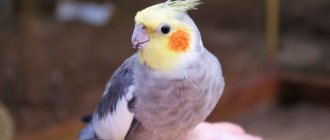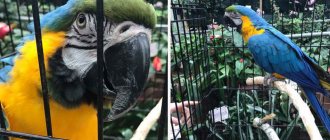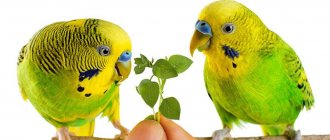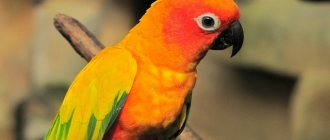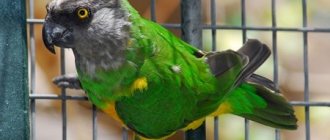Aratinga parrots live in the highlands of South and Central America. These are beautiful, active and very intelligent birds that are easy to train and therefore often become human companions. In addition, the owner will not have to worry about how long Aratinga Yandaya parrots live or how to prolong their life; as a rule, birds live longer at home than in the wild.
Appearance
The rainbow and sun parrot Aratinga Yandaya lives in the wild in Central and South America. The body is usually light green or yellow, but the edges of the feathers are orange, red, blue and even purple. Such beautiful iridescence is rarely seen in any bird. There are ocular rings around the eyes of the Aratinga Yandaya parrot. Its tail is wedge-shaped, the feathers are arranged in steps, their length does not exceed the length of the body, which means that each tail feather is on average from 16 to 40 cm in length.
ARATINGA - ARATINGA
Aratinga
Dimensions 16-42 cm. They do not have pronounced sexual dimorphism in plumage color.
They live in Central and South America. They inhabit multi-tiered and cleared forests. They feed mainly on plant foods. During the breeding season, a pair of aratha occupies a separate nesting site. They nest in tree hollows, sometimes gnawing out rotten wood and creating nesting niches on their own. The birds' strong beaks contribute to this. There are 3-5 eggs in a clutch, which are laid at intervals of 2-4 days. Incubation lasts 24-28 days. The male feeds the female and guards the nest. The young leave the nest at the age of about two months. The genus includes 21 species. Golden aratinga (Aratinga guarouba)
Body length 36-40 cm, tail about 16 cm. The color of the plumage is golden yellow. There is an unfeathered white area around the eyes. The flight feathers are dark green. The tail is yellow. The beak is powerful, large and light.
It lives in the northeast of Brazil, its range is limited to certain areas in the interfluve of the lower reaches of the Tapajos and Tocantins rivers.
In nature, they live in pairs or small flocks except during the breeding season. They inhabit forests closer to water. They prefer the tops of trees, quickly flying from one tree to another.
They nest in tree hollows. There are 3-5 eggs in a clutch. Incubation lasts about 22 days, the chicks leave the nest after 6-7 weeks.
The attractive coloring and unpretentiousness of these parrots to the conditions of captivity led to their massive capture, but the destruction of indigenous habitats caused more harm to the population. By the middle of the 20th century, these parrots had become rare in nature. Currently, the golden aratinga is an endangered species. It reproduces quite well in nurseries. This is the most beautiful species of this genus. Golden aratings have a high ability to reproduce various sounds: whistling, squeaking, coughing and human speech.
Red-headed Aratinga (Aratinga erythrogenys)
Body length 33 cm. The main color is green, sometimes with occasional splashes of red feathers. The crown, forehead and sides of the head are red. The plumage of the wing in the middle part of the inner side and the blade is red. The unfeathered area around the eyes is white. The beak is flesh-colored. The iris is yellow. Females and males are colored the same.
It lives on the southwestern coast of Ecuador and northern Peru in arid areas, living in flocks of 6 to 10 birds.
They usually nest in tree hollows. There are from 3 to 4 eggs in a clutch. The female incubates the clutch for 23-24 days; at 2 months of age, the fledged chicks leave the nest.
Aratinga cactus (Aratinga cactorum)
Body length 25-26 cm. The color of the upper back is dark green. The crown and forehead are blue-gray. The top of the head and neck are brown-green. The upper part of the breast and throat are grey-brown. The lower chest and belly are yellow-orange. The unfeathered area around the eyes is white. The beak is light. The female has a brown head and neck, a slightly smaller and thinner beak. The male's iris is brick-red, the female's is yellow-brown.
It lives in the northeast of Brazil, inhabits arid steppe areas overgrown with low-growing bushes and cacti. Outside the nesting period, it leads a nomadic lifestyle. The birds are quite shy and have a loud and shrill voice. They feed on flowers and fruits of shrubs and cacti, buds and other plant foods.
It usually nests in the hollows of large cacti. Less often uses tree hollows for nesting. The clutch contains from 3 to 6 white eggs 25.4 by 19.6 mm, which the female incubates for 24 days. The chicks fledge at about 2 months of age. Young birds have a green crown, a lighter beak, and an olive-colored lower body. Young birds artificially raised by humans become completely tame and can learn to pronounce a few words. With proper care they can live up to 35 years. The species includes 2 subspecies. Aratinga cactorum cactorum - the nominate subspecies is distributed in the southeastern part of its range. Aratinga cactorum caixana - distributed in the northeastern part of the range.
Yellow-eared Aratinga (Aratinga icterotis)
Body length 40-42 cm. Color green with a yellowish tint in the lower part of the body. The frenulum, forehead, cheeks and parotid area are yellowish-green. The inside of the tail feathers is pale red-brown, the outside is green. The upper side of the flight feathers is blackish at the ends. The upper part of the beak is blackish, the mandible and tip are light.
Lived from Colombia to Ecuador, currently from the territory of Ecuador, probably disappeared.
They inhabit subtropical and temperate forests on the slopes of the Andes at an altitude of 2000-3000 m above sea level. Colonies of these parrots were found in plantations of wax palms (Ceroxylon quindiuense).
It nests in hollow palm trunks, usually at an altitude of 25-30 meters above sea level. The nest is used by the parrot throughout its life. A very rare species.
Aratinga finschi
Body length about 29 cm; weight about 160 g. The main color of the plumage is green, shiny on the head. The abdomen is yellowish-green, the wings are dark green. He has red areas on his forehead and head. The wings have shiny orange feathers. The tail is long and sharp. The beak is pinkish in color with a darker tip. Paws from gray-pinkish to dark gray. The iris is orange-red. They live in eastern Costa Rica, southern Nicaragua, and western Panama.
They inhabit subtropical and tropical rainforests, forest edges, coffee plantations and agricultural lands with few plants. They live in flocks of up to one hundred birds. They feed on a wide variety of fruits, flowers, plants and grains. Pairs form for life. They nest in tree hollows. There are from 2 to 4 eggs in a clutch.
Orange-fronted Aratinga canicularis
Body length 28 cm, weight 80 g. The main color of the plumage is olive green with a lighter shade on the ventral side. The flight feathers are dark green, the tail feathers are yellow-green or light green below, and dark olive above. The unfeathered area around the eyes is yellow-orange. Ivory beak. They live along the western coast of Central America from Mexico to Costa Rica.
Outside the mating season, they live in large flocks that can reach up to 100 birds. They feed on various seeds, flowers and fruits. There are 2-3 eggs in a clutch. The chicks hatch after 4 weeks. At about 2 months of age, the feathered chicks fly out of the nest. The species includes 3 subspecies:
Aratinga canicularis canicularis Aratinga canicularis clarae Aratinga canicularis eburnirostrum
Sharp-tailed Aratinga (Aratinga acuticaudata)
Body length 35-37 cm; weight - 140-190 g. Green plumage. The cheeks, forehead, crown, as well as the area around the ears and around the eyes are blue. The inner side of the lateral tail feathers is blood-red in color with a brown tint. The flight feathers are black at the end. The beak is light with a black tip on the mandible. Paws are pink-brown. They live in eastern Bolivia and Colombia, northern Argentina, Paraguay, Venezuela and Uruguay.
They inhabit fields, forest edges, and semi-arid areas. These intelligent, very active birds are popular among nature lovers. They reproduce human speech relatively well for aratinga. The species includes 5 subspecies.
Aratinga acuticaudata acuticaudata Aratinga acuticaudata haemorrhous Aratinga acuticaudata koenigi Aratinga acuticaudata neoxena Aratinga acuticaudata neumann
Golden-capped aratea (Aratinga auricapillus)
Body length 30 cm. The plumage is green, the back of the head and forehead are red, the unfeathered area around the eyes is the same color. The abdominal area is reddish-brown.
Some parrots have patches of yellow feathers among their red plumage. The lower back and sacrum have a red-brown border. Among this species there are many variable colors. They live in eastern Brazil (in Bahia, Minas Gerais, northern Paraná and southern Goiás) and in Paraguay.
They inhabit subtropical and tropical forests, dry savannas and plantations. In nature they live in pairs or small flocks of 4 to 10 birds. They feed on seeds and fruits. They nest in tree hollows and under the roofs of houses. There are 2-4 eggs in a clutch. After about 24 days, the chicks appear, and at 1.5 months of age they fledge. The species includes 2 subspecies. Aratinga auricapillus auricapillus Aratinga auricapillus aurifrons
Brown-cheeked Aratinga (Aratinga pertinax)
Body length is about 25 cm. The main color of the plumage is green. The head and chest are copper with an orange-yellow tint.
They live in Brazil, Colombia, Costa Rica, the Dominican Republic, French Guiana, Guyana, Mexico, Panama, Suriname, Venezuela, the Netherlands Antilles, the US Virgin Islands, Puerto Rico, Aruba and Barbados. They inhabit subtropical and tropical forests.
Golden-fronted Aratinga (Aratinga aurea)
Body length 26 cm. The plumage is green, the lower part of the body has a yellowish tint. The crown is blue-green, the forehead is in red and orange tones. The upper chest and throat are brown. The iris is orange-red.
The coloring of males and females is the same, the females have a thinner beak and the males are slightly larger than the females. They live in Brazil, Peru, Suriname, eastern Bolivia, northern Paraguay and northwestern Argentina.
They inhabit the edges of subtropical and tropical damp forests, dry savannas, parks and gardens. They live in pairs and small flocks of 4 to 8 birds. Sometimes the flock reaches 20 to 30 birds.
The female lays 2-5 white eggs and incubates them for 21-26 days. Some males enter the nesting areas during incubation, but do not take part in the incubation. The chicks leave the nest at the age of 50 days. They resemble their parents in color, but the orange stripe on the crown is narrower and lighter, the blue on the back of the head is paler, the beak is lighter and the iris is gray.
Sun Aratinga (Aratinga solstitialis)
Body length 28-30 cm; weight 110-120 g. The birds have a very bright yellow color. The face and belly are orange. The wings and tail are green. The legs and eye ring are gray. It is almost impossible to distinguish a male from a female. It lives in Guyana, southeastern Venezuela and northeastern Brazil.
They inhabit palm groves and savannas. Outside the breeding season, parrots gather in flocks; during the nesting period they live in pairs or groups. They feed on fruits, vegetables, nuts, etc. They are very cautious birds; in nature they are more likely to be heard than seen. The male and female are very attached to each other. They spend most of their time together, preening each other's feathers and feeding together.
They begin breeding at the age of 4 years. They nest in tree hollows, most often palm trees. There are 2-6 eggs in a clutch. The female incubates them for about 23 days. The young leave the nest at the age of 3 months. This bird was first imported to Europe in 1862. In captivity they live up to 28-35 years.
Red-faced Aratinga mitrata
Body length is 36 cm. The plumage is green, there is a red “cap” on the head, and small red spots on the front of the body. The tail is long, wedge-shaped, stepped.
It lives in northern Venezuela, western Ecuador, southern Peru and Colombia. Inhabits deciduous and humid forests up to an altitude of 1000 to 300 m above sea level.
When mating, both partners make circular movements with their heads and often touch their beaks. The female lays 2-5 white eggs, on which she sits for 28 days. During nesting, birds behave very aggressively. Young birds leave the nest at the age of 7 weeks. Unlike adult birds, they are completely green, only their beak is yellow.
Young birds raised artificially become very sociable, become attached to their caregiver and can learn to pronounce a few words. The species includes 4 subspecies.
Aratinga mitrata alticola Aratinga mitrata chlorogenys Aratinga mitrata mitrata Aratinga mitrata tucumana
Aratinga jandaya
Body length is 30 cm. It is very difficult, almost impossible, to distinguish a female from a male by color. But the female has a slightly paler orange tint on the lower part of her body. This is not an important factor, because the shade may depend on the general condition of the bird and its age. Lives in Brazil.
It feeds on berries, seeds and other plant foods. Often causes damage to corn plantations. With the exception of the nesting period, parrots stay in small groups.
The female lays 3-5 eggs at intervals of 3-4 days. Incubation duration is 26-30 days. Young birds leave the nest at the age of 8 weeks. Outwardly, they are similar to their parents, but their head and upper chest are yellow, the lower chest and belly have a faint orangish tint. The beak is lighter.
White-eyed Aratinga (Aratinga leucophthalmus)
Body length is about 32 cm, wing length - 166-188 mm. The main color of the plumage is green with red accents on the head and neck. There are also red-yellow feathers on the wings. The clearly visible white ring around the eye gives this species its name. The iris is orange. Young birds lack red feathers on their heads and wings.
It lives from eastern Colombia to Guyana, south to Argentina and Uruguay. They live in pairs or small flocks of 10 to 20 birds. Their flocks reach up to 200 birds. Nomadic birds, sometimes living with sharp-tailed aratinga acuticaudata. They feed on seeds, nuts, and fruits. There are 3-4 eggs in a clutch. Incubation lasts about 26 days. The chicks leave the nest after approximately 8 weeks. The species includes 4 subspecies:
Argentine White-eye Aratinga Aratinga leucophthalmus propinquus Colombian White-eye Aratinga leucophthalmus nicefori Peruvian White-eye Aratinga leucophthalmus callogenys Aratinga leucophthalmus leucophthalmus is the nominate subspecies.
Haitian aratinga (Aratinga chloroptera)
They live in the Dominican Republic, Guadeloupe, Haiti, and Puerto Rico.
Body length 25-26 cm. They inhabit subtropical and tropical forests and arable lands. Endangered due to loss of natural habitat
Nicaraguan Aratinga (Aratinga strenua)
Length 24-26 cm.
It is endemic to the small region of El Chocoyero - El Brujo in western Nicaragua. The nesting grounds lie within this protected area.
Colombian Aratinga wagleri
Body length 33-35 cm, tail 15 cm. The color is green with a shiny tint, the underside is lighter. The flight feathers and tail below are olive-yellow. There are red transverse stripes on the crop and throat.
Found in Colombia, Peru, Ecuador and Venezuela. Inhabits subtropical and tropical forests. The species includes 4 subspecies:
Aratinga wagleri frontata Aratinga wagleri minor Aratinga wagleri transilis Aratinga wagleri wagleri
Guatemalan Aratinga (Aratinga holochlora)
Body length 27-31 cm, tail 14 cm. This is a beautiful parrot with shiny green plumage and lighter coloring in the lower part of the body. The middle of his tail is green, and the edges are gray. The beak has a dark pinkish tint.
It lives in Mexico, Guatemala and northern Nicaragua. They inhabit forests and parks. It feeds on seeds, various fruits and grains. Sometimes they damage corn and sorghum crops. They nest in tree hollows. There are 3-4 eggs in a clutch. The species includes 4 subspecies:
Aratinga holochlora brevipes Aratinga holochlora brewsteri Aratinga holochlora holochlora Aratinga holochlora rubritorquis
Nandaya or black-headed aratinga (Aratinga nanday)
Habitat: Paraguay, Southeast Bolivia, northern Argentina and Brazil. Body length 30 cm, tail 18 cm. The main color of the plumage is green. The cheeks, forehead, crown and throat are black. There is a white unfeathered area around the eyes. The crop and breast are green-blue. The abdomen is green. The wing plumage is black and blue. The tail feathers are light olive green. The flight feathers are blue. The rump is green with blue edges. The tail feathers are olive green above and grey-brown below. The legs are red at the bottom and green at the top.
These unpretentious parrots take root well at home and reproduce quite well. The clutch contains from 3 to 6 eggs. After 25 days, the chicks will lie down, at about 1.5 months of age they fledge and fly out of the nest.
Brown-headed Aratinga (Aratinga weddellii)
Small parrots 16 cm long and weighing 90-110 grams. The main color of the plumage is green, the head is grayish-brown. Legs are grey. The male is larger than the female.
Lives in Colombia, Ecuador, Peru, Bolivia in the Amazon basin. Under natural conditions, it inhabits arid areas with cactus vegetation. They live in pairs or flocks of 3 to 8 birds. They feed on fruits, seeds, and flowers, as well as insect larvae. There are from 3 to 5 eggs in a clutch. The incubation period lasts 25 days. The chicks fledge at about 2 months of age.
Jamaican Aratinga (Aratinga nana)
The length of the parrot is 26-28 cm. They live in Belize, Costa Rica, the Dominican Republic, Guatemala, Honduras, Jamaica, Mexico, Nicaragua, Panama and the Cayman Islands. They inhabit subtropical and tropical rainforests.
Characteristic
The size of the bird depends on the species, there are about 20 such species in total (Guadalupe parrot Aratinga Yandaya), which is already considered extinct. The weight of an adult is 100-150 g with a height of 16-40 cm.
The main characteristics of most representatives of the Aratinga Yandaya parrots include:
- powerful, thick, but short beak;
- the presence of a forelock above the beak, such a decoration is found, for example, in the orange-fronted;
- bright spots on different parts of the body, the head of the golden-fronted parrot Aratinga Yandaya is decorated with a golden circle.
It is impossible to distinguish a male from a female either by weight, or by the color of plumage, or by any other characteristics, either at home or in captivity. Only an ornithologist or an experienced veterinarian can determine the sex.
The most common species of Aratinga parrots
| View | Aratinga | |||
| Genus | Aratinga | Eupsittula | Thectocercus | Psittacara |
| Guaruba | Ognorhynchus | Nandayus | ||
| Kinds | ||||
| Blue-fronted | Golden-browed | Golden-capped | cactus | Orange-headed |
| Haitian | Redhead | Cuban | Finsha | Hock |
| Mexican | Yandaya | White-eyed | Red-faced | Jamaican |
| Brown-cheeked | Pintoi | Solar | Nicaraguan | Colombian |
| Brownhead | Guadalupe (extinct) | Gold | Yellow-eared | Blackhead |
| The following Aratinga are popular among ornithologists: | |
| View | Photo |
| Orange-fronted Aratinga canicularis | |
| Solar aratinga Aratinga solstitialis | |
| Red-headed Aratinga erythrogenys | |
| Cuban Aratinga euops | |
| Brown-headed Aratinga lathami | |
| White-eyed Aratinga leucophthalmus | |
| Golden-capped Aratinga auricapillus | |
| Yendaya Aratinga jandaya | |
The most popular and affordable parrot is the Sunny Aratinga parrot.
Behavior and character
Aratinga Yandaya parrots cannot be called calm or even docile; they are in constant motion, which is due to the lifestyle they lead in the wild. These are inhabitants of multi-tiered forests. They prefer large companies of their relatives to the silence and comfort of solitary existence. The only chance of meeting a single bird occurs during mating games and subsequent incubation of the chicks.
Once a couple is formed, they will never separate. The family will find a place for laying somewhere in a deep crevice or hollow of a tree, perhaps building a nest on its own from feathers, grass and branches. At home, the female also builds a nest from scrap materials provided to her by humans.
After 2-4 eggs appear in the nest of the Aratinga Yandaya parrot, the female begins incubation, which lasts up to 1 month. The chicks are cared for until they acquire independence, this happens after 2-2.5 months. Then the family, along with its adult offspring, returns to the common flock. The school lifestyle helps them feel safer, hide from predators and look for food.
Many individuals love to sharpen their beaks on various wooden surfaces. Having got such a tree-lover at home and periodically letting him out for a walk around the room, it is worth remembering that even one pet can in a matter of minutes cause irreparable damage to the furniture and everything wooden that is in the apartment. If you have purchased a couple, then it is extremely undesirable to let them out of sight.
You can reduce the risk of unpleasant consequences by constantly slipping tree branches to your poultry.
Golden Aratinga - large two-color beauty
The lemon-yellow color allowed this bird to get its name by analogy with the most beautiful and popular precious metal. The plumage can be diluted with light or emerald green feathers. As a rule, these contrasting “inserts” are located on the wings. The bird's beak has a steel-silver tint, and the eyeliner that outlines the eyes is snow-white. Often, several small greenish spots stand out on the lemon-yellow head feathers.
The golden aratea is larger than its fellows. The total body length is 35-38 centimeters, and the tail length is about 16 centimeters. The color is more sparse. The plumage of other parrots can include up to 5 colors, while the feathers of these large individuals have only 2.
Spreading
The homeland of Arating parrots is America. They can be found in the deciduous forests of Brazil (aratinga yandaya and golden), mainly in highlands, on the edges of damp forests, in parks and savannas of Peru, Bolivia and Argentina (golden-fronted).
In the past, they were found everywhere throughout the entire territory of these countries, but the spread of predators, the transfer of their habitat from familiar lands to unfamiliar places, which occurred under human influence, had a significant negative impact on the number.
Farmers who grow vegetables and fruits near the area favored by the Yandaya aratinga parrots destroy them by the dozens, quite reasonably fearing for their harvest.
Nutrition
In natural conditions, bright parrots feed on fresh leaves, greens and fruits. They do not disdain grain that has ripened in the farmers’ fields. In captivity, it is recommended to add nuts, egg mixture, white bread and mineral supplements to their regular food. This diet allows you to maintain the healthy appearance of the birds and the brightness of their color. Water is also extremely important for them.
The Aratinga parrot does not accept animal food, so you should not offer it such mixtures. If a curious bird wants to try food from the human table, it is better to stop such attempts. It is not advisable for these parrots to consume salt, chocolate, avocados, sugar, cold and hot foods.
Content
At home, in captivity, Yandaya parrots behave approximately the same as in the wild. Their character, lifestyle and behavior do not change at all, except that many individuals become more sociable. Representatives of this species tend to choose a favorite among people, for whom they:
- dancing funny dances;
- teach quatrains;
- learn words.
Pets do not have a large vocabulary, but they remember a song or poem, especially if the person they choose likes it. At the same time, with the same ease, a home arating yandaya will forget the learned lines and start learning something new.
Cell
The cage needs to be spacious. Its width should not be less than 1 meter and its height 2.5 meters. It is better if it is made of metal. A nest, drinking bowls and feeders are placed in the cage. Perches and all kinds of toys are vital - rings, ropes, swings, tassels.
Nutrition
In the wild, they feed on green leaves of various trees, fruits and vegetables, and grain, which greatly annoys farmers and local residents. At home, they feed nuts, boiled eggs, white bread, diluting all this with mineral supplements. There should always be fresh water in the drinking bowl.
Domestic Yandaya parrots are not omnivores, so you should offer them new food with caution. Thus, poultry do not like food of animal origin. Stealing food from the dinner table, as well as eating chocolate, salt, sugar and some fruits such as avocado, should not be allowed. Hot or too cold foods are also excluded from the usual diet.
Diseases
With proper care, domestic parrots Aratinga Yandaya almost do not get sick, but this does not eliminate the need for regular veterinary examinations, at least once every six months.
general description
Appearance
Despite their modest size, most varieties of aratinga amaze with their luxurious appearance. They really resemble a miniature arar - the same bright plumage, a long stepped tail and a large, powerful beak relative to the head.
Appearance of the Arating parrot
The parrot's body length is 16-42 cm, weight is about 100-130 grams. The coloring is done in various shades of yellow, green, blue and red. Around each eye there is a white ring, devoid of feathers. The beak is large, strongly rounded, with a clear tooth-like notch, often dark brown or black. The tail is straight, wedge-shaped.
Intelligence and character
These birds have extraordinary intellectual abilities and a cheerful and friendly disposition. The bird becomes strongly attached to the person who cares for it, accompanies him everywhere and gets bored during a long absence. For this, owners often lovingly call their pets little “tails” and “stickies.” Aratingas are very affectionate, they love to bask in the hands of a person when their plumage is sorted, stroked on the head and neck, and “sniffed” under the wings.
Characteristics of the Aratinga parrot
The Aratinga behaves friendly towards other pets and family members, happily involving both birds and animals in joint games. Mischievous parrots enthusiastically learn everything new and never go without entertainment for an hour. Therefore, your pet should have as many interesting things as possible for his leisure time freely available. And yet, it is spending time in the company of a person that brings real pleasure to the Artings.
Negative character traits of parrots of this species include the birds' noisiness. They often, especially in the morning, emit sharp, loud screams. At the same time, the pets communicate with each other by quiet cooing. Another disadvantage of keeping aratinga at home is its destructive, powerful beak. However, if you have a sufficient amount of branch food and properly raise your pet, you can avoid damage to furniture or household items.
The aratinga has the ability to imitate various sounds, like all parrots. But they learn to speak poorly. According to reviews from amateurs, it is known that some birds are able to remember one or two dozen words, but in general you should not expect long monologues from them. But the favorites reproduce their speech in the funny voice of Donald Duck from the Disney animated series. Birds achieve great success in imitating musical melodies and the noise of household appliances.
Arating parrot's learning ability and intelligence
Conditions
Poultry are terribly clean, the cage in which they live, as well as all surfaces accessible to them, must be wiped with damp cloths daily. Food is removed from the feeder immediately after saturation, the water is changed several times a day. We'll have to arrange a place for swimming. If the room temperature is above +23 degrees Celsius, you can spray the bird with warm water from a spray bottle.
Air humidity should not be less than 60-70%. The nails of poultry are regularly cut.
You can expect unexpected surprises from pet Yandaya parrots. For example, many people throw food into water before eating. To avoid food souring and wasting it, food bowls are placed as far as possible from the water bowl.
Some owners don't like the loud voice of their new pet. This is something to consider when purchasing domesticated Aratinga Yandaya.
Habitat
Australia is considered the homeland of this species of parrots. Until the 1900s, the budgerigar was the most numerous bird on this continent. Today, parrots of this species abundantly inhabit the southwestern and eastern coasts, but their numbers have noticeably decreased. You can also meet representatives of the genus on the island of Tasmania, located near Australia.
For nesting, parrots choose semi-desert areas where there is enough food and water. When a budgerigar settles depends on when it will breed. Birds that choose the north of the continent as their place of residence can breed at any time of the year, except the rainy season. Birds living in the north of Australia give birth to chicks only from November to December.
Today, the budgerigar is more often found in captivity than in the wild. This is due both to changes in the landscape of the continent and the mass capture of birds in the 1850s, and to their consumption by local aborigines. It was they who gave these birds the name “bedgerigas”, meaning “fit for food”.
Price
The average price is 15-25 thousand rubles. It depends on age and color, complaisance and ability to talk, readiness to communicate with people. Sunny and black, nandayas are more expensive than simple green ones.
Yandaya parrots are the most famous birds of their kind. They adapt well to any living conditions, learn quickly, become attached to their owner, and can speak and even recite poetry. In the wild they live for about 15 years, but in captivity they can live up to 25-30 years. Unpretentious to keeping at home.
Previous
All types of Venezuelan Amazon and its features
Next
All types of New Zealand parrot Kea and its features
Reproduction and lifespan of aratinga
They can begin to reproduce as early as 2 years of age, but usually this occurs at 4 years of age. They lay 3–6 eggs once or twice a year and incubate them for 26 days. Two to four days pass between the laying of two eggs. While the female incubates the eggs and cares for the babies, the male feeds her and guards the nest.
At birth, the weight of the chicks is about 5 grams. The chicks begin to fly approximately 6 weeks after hatching. At the beginning of life, their color is dull, a constant color appears by the second year of life.
To hatch chicks, it is advisable to purchase or build a special house. Aratinga live from 15 to 30 years (subject to good care and proper feeding).
Wild Lifestyle
Under natural conditions, they have chosen the central and southern parts of America. They inhabit dense multi-tiered forests, where they can safely hide from the heat and uninvited predatory visitors. Aratinga parrots live in flocks, and during the nesting period they exist in pairs. Bird unions are famous for their longevity and strength. They make cozy nests in crevices and hollows of trees, sometimes making them themselves.
Incubation lasts almost a month. Usually there are from 2 to 4 eggs in a clutch. Responsible parents raise their offspring until the chicks become independent and leave their father's house.
